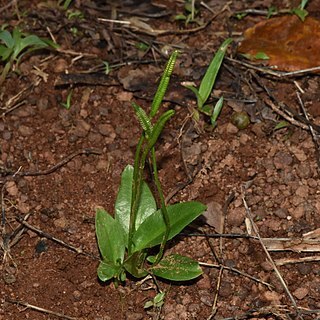Plants 3-8 cm tall. Rhizomes erect, very thick, with numerous fibrous roots, usually bearing 2 or 3 fronds. Common stalk grayish green on most parts from being buried underground, 1.5-3 cm. Sterile lamina elliptic or elliptic-ovate, 1-3 × ca. 1 cm, subfleshy, base shortly cuneate, margin entire, apex acute or rounded; veins indistinct. Sporophore 4-5 cm, arising from base of sterile lamina; spike short and thick, 1-2 cm, surpassing sterile lamina 1-2 times, apex acute; sporangia 10-18 pairs. Spore surface coarsely reticulate. 2n = 240-480.
Rhizome linear, up to 20 mm long, up to 3 mm in diam.; roots with proliferous buds. Leaves 2-5 per plant. Stipe up to 18 mm long, 80-100% subterranean. Lamina midgreen, held at 10°-30° from the horizontal, elliptic to narrowly ovate, shallowly canaliculate, up to 22 x 9 mm, apex acute, apiculate, base broadly cuneate. Fertile spike up to 35 mm long, diverging from stipe from near its base, with up to 9 sporangium pairs, apiculus pronounced.
Rhizome cylindrical, 2 mm in diameter. Fronds (1-)2-3; stipe subterranean, 2-20 mm long; stipe bases persistent; sterile lamina held horizontally, somewhat coriaceous, ovate to broadly ovate, up to 80 x 4 mm, mucronate, base cuneate; venation usually obscure; fertile spike inserted some distance below base of sterile lamina, arising below ground level, c. 7-30 mm long with 2-9 pairs of sporangia, apiculus subulate, attenuate, 1-2 mm long.
Perennial with linear rhizome, with persistent leaf bases, roots proliferous, leaves 2-5, tropophore elliptic to narrowly ovate, up to 35 mm long. Sporophore inserted at tropophore base, up to 50 mm long, with 5-9 sporangium pairs.
A fern. It grows 8 cm tall. The rhizomes are small and with small tubers. The fronds are distinct. The sterile fronds are 2.5-7 cm long by 2-3.5 cm wide. They are narrow and oval. The fertile fronds are about 2.5 cm long.
Perennial with linear rhizome, roots proliferous. Leaves 2-5, tropophore elliptic to narrowly ovate. Sporophore to 4 cm long, with 5-9 pairs of sporangia.


